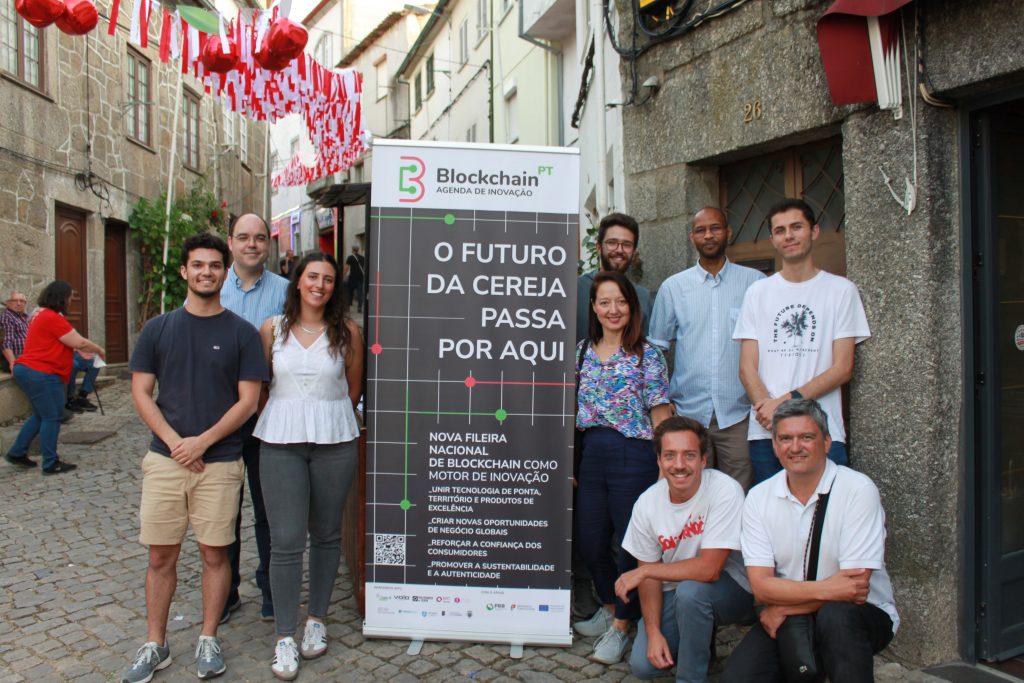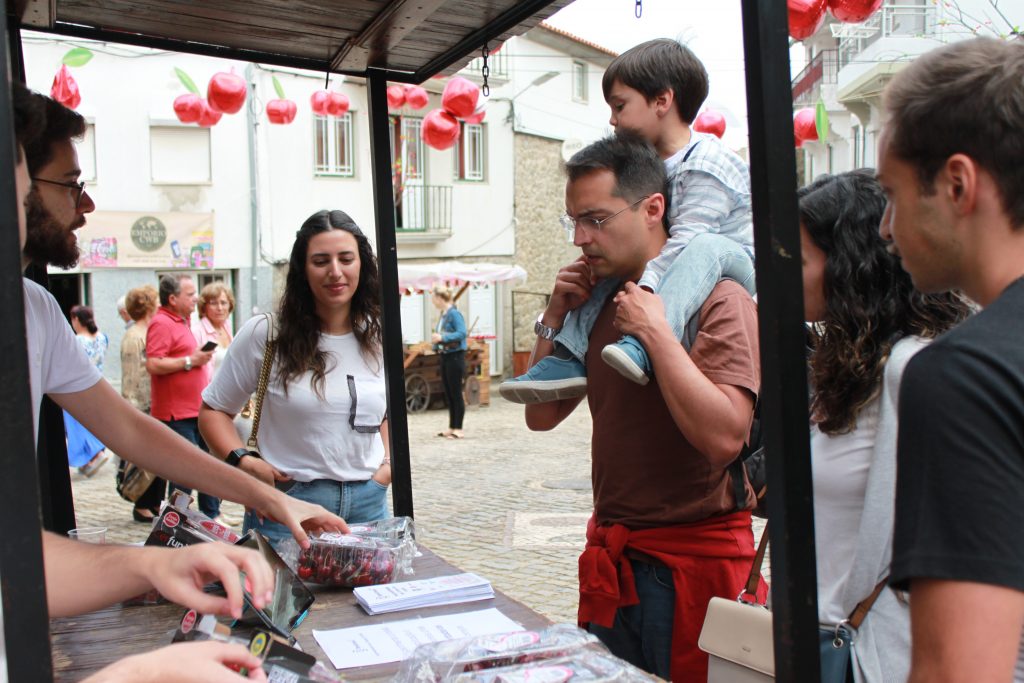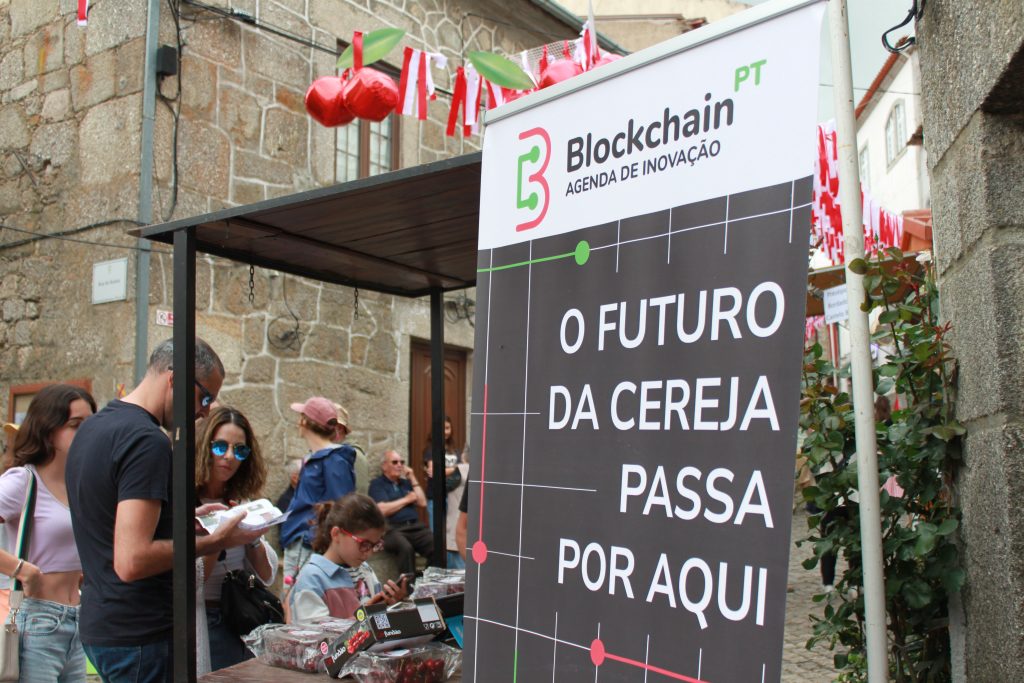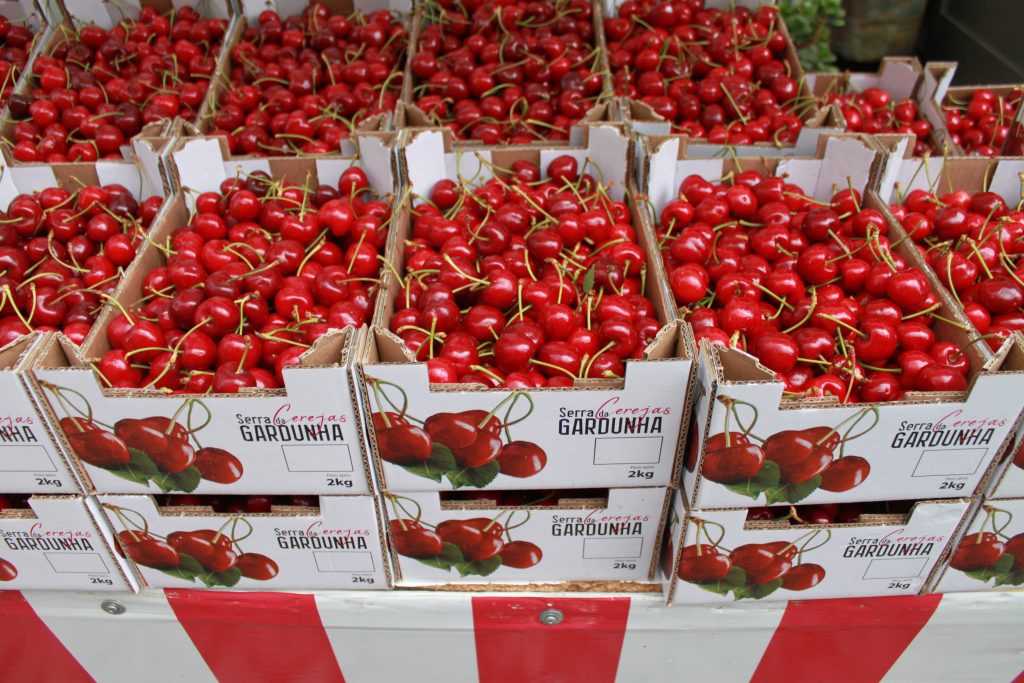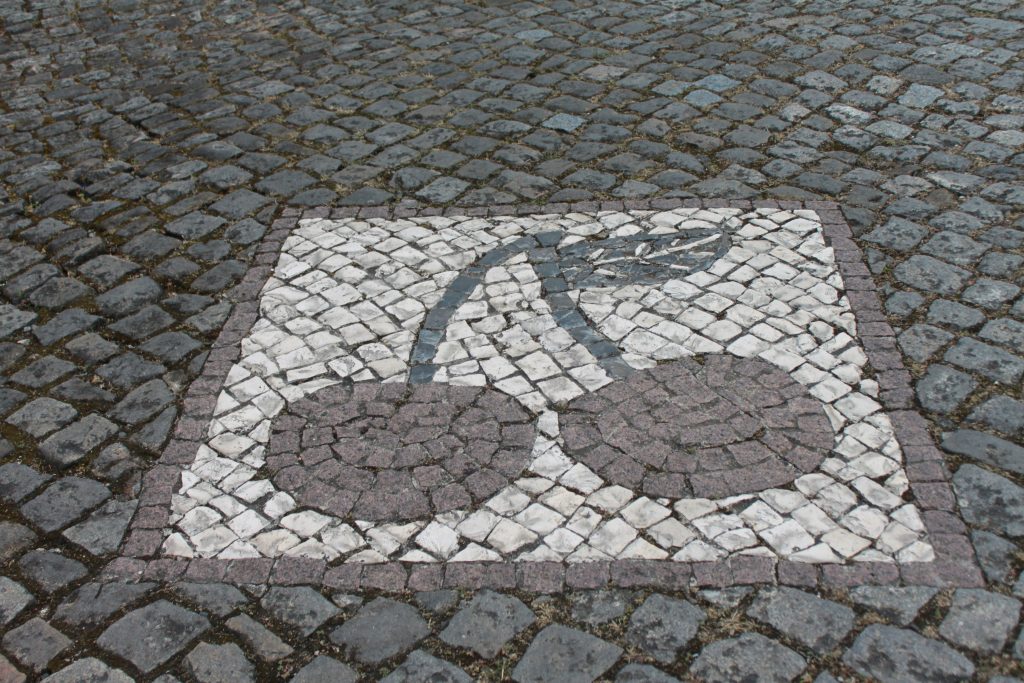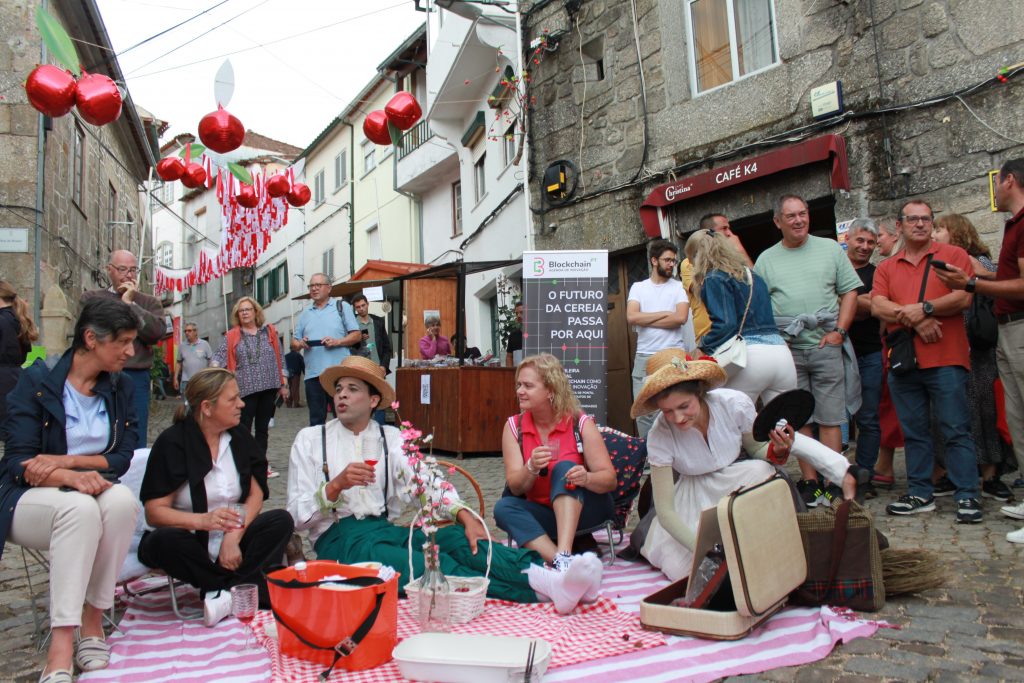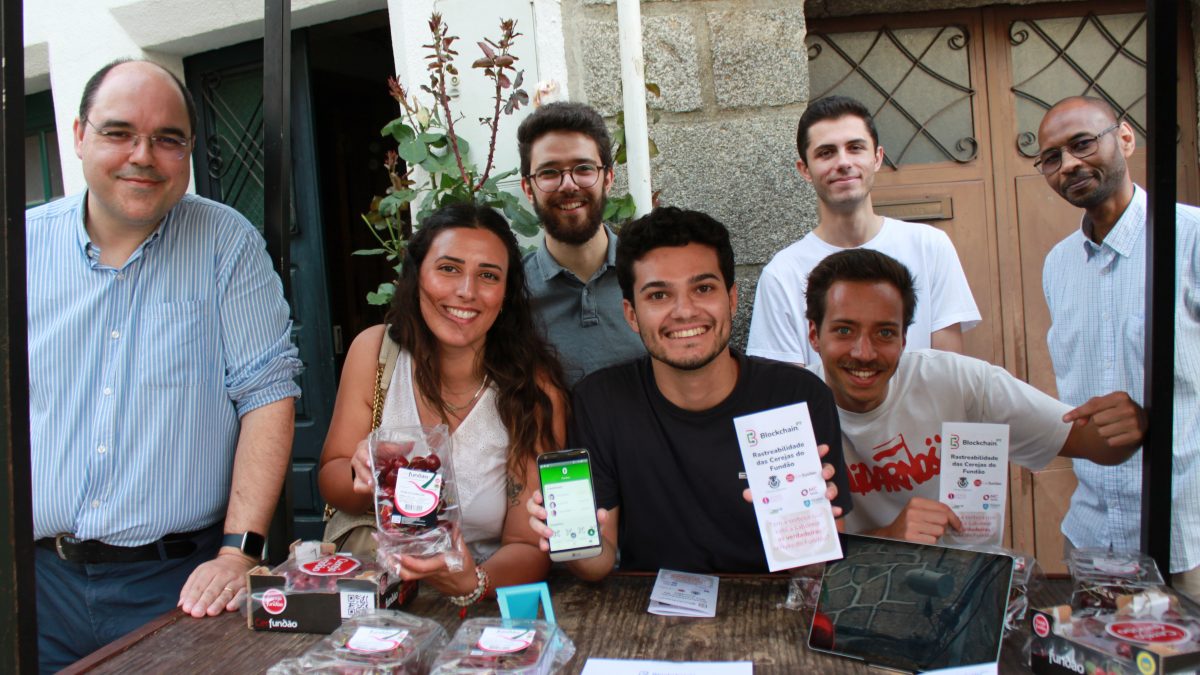
INESC-ID researcher, Miguel Pardal, a team of master students, and Mariana Salvado, from Câmara Municipal do Fundão, presenting the demo of Blockchain.Pt to visitors of Festa da Cereja
PRR Projects: Mirror, mirror on the wall, am I real or am I fake?
Working in agriculture is exhausting, unpredictable, and sometimes not financially rewarding. Miguel Batista is a son, grandson and a great-grandson of cherry producers and he surely knows what he is talking about when mentioning the hardships, and also the joy, of living off farming. “I am afraid my son will not be a cherry producer”, he admits while talking at a debate taking place at Festa da Cereja, in Alcongosta, Fundão. Under the name “Cherry 4.0 – on the road to modernization”, organized by the Ciência Viva Agency and the Fundão Municipality, the gathering joined cherry producers, scientists and technology people. Batista, from the company Sota e Lino, provided the motto for the discussion. “When I started 30 years ago, no one checked the labels. Nowadays, everybody does.”
And there is a lot of information that can be added to a label, like the origin, carbon footprint, fertilizers used during cultivation, all of this weighs increasingly more when the consumer decides. The Agenda “Decentralize Portugal with Blockchain”, funded under the PRR (Programa de Recuperação e Resiliência), in which INESC-ID is one of the promoters, aims to create a national blockchain network, preparing the country to be a world leader in the technology. It was also showcased during the debate.
Coordinated by VOID Software and comprising 56 entities, including companies, research institutions, associations, and public bodies, “Decentralize Portugal with Blockchain” is organized into ten work packages addressing sectors like agriculture, digital asset management, and interoperability. With an investment exceeding 72 million euros, the agenda aims to launch 26 scalable products with significant export potential. Key focuses include “farm-to-fork” traceability integrating IoT with blockchains, managing digital assets in real estate and beyond, and interoperability solutions for data exchange between diverse blockchain systems and technologies across sectors. The end goal, as described on the project’s website, is “to propel Portugal to the forefront of blockchain technology in Europe and advance the country’s digital transformation.”
Tracing the origins of Cereja do Fundão
One of the proposed applications – Work Package 1 – is concerning the traceability of Cereja do Fundão. Fundão Cherries, cultivated in the Cova da Beira region of Portugal, stand out for their superior quality and unique characteristics that make them valuable in the market. However, it is important that they are authentic and monitored from origin to consumer. So, the goal of this demonstrator is to develop a first version of an innovative information system to ensure the traceability of Fundão cherries from harvest to consumer, with the vision of the “importance of technology as a driver of innovation and taking advantage of global business opportunities made possible by this technology”, notes the coordinator of the project, Miguel Pardal, an INESC-ID researcher, from Distributed Parallel and Secure Systems, and a professor at Técnico. “The use of Blockchain aims to ensure the integrity of the collected data, providing a reliable source of information about the origin and quality of cherries”, Pardal explains. “Unlike traditional databases, it is not under the control of a single entity but rather involves a network of partners, including producers, distributors, retailers, and technology providers.”
Festa da Cereja, in Alcongosta, was the perfect opportunity to demonstrate it to the population and test its impact. The demonstrator, developed in collaboration with the organization of cherry producers Cerfundão, the retailer Sonae MC and the technology company Sensefinity, included an app through which consumers can have access to the information.
Visitors passing through the main street of the mountain village during Festa da Cereja were looking for the traditional cherry products, like pies and liquors. But they also found technology. For two days, on the stand of Blockchain.pt people could test the system and become familiar with the main aspects of the project. By reading the QR code on the box, the app would show the community area (freguesia) in which it was produced and all the steps the fruits have gone through to reach the customer. “The focus of this initial demonstrator is the assurance of origin and, therefore, the locations involved in the supply chain. In the future, the system will include integrated sensors for temperature, humidity, light, and vibration, for example, in field boxes and packaging labels, to enable better monitoring of transportation and storage conditions”, Miguel Pardal explains.
Where technology meets tradition
The project involves a group of master students, working on the app in order for it to be appealing to end users, with a gamification component. All the server programming is also with INESC-ID. The smart label is being developed by Sensefinity with the data sent through LoRa net. The position, detected by GPS, is communicated every five minutes, from the fields to Cerfundão, and then on every thirty minutes. The labels are attached to the boxes and pallets and the sensor also registers temperatures and humidity. “These data can be relevant in case there is some sort of sanitary problem”, underlines the CEO of Sensefinity, Orlando Remédios.
The system will be integrated with the enterprise information systems of the partners involved in the supply chain. The use of Blockchain aims to ensure the integrity of the collected data, providing a reliable source of information about the origin and quality of the cherries. “Unlike traditional databases, this information is not controlled by a single entity, but by the group of partners involved in the system, including producers, distributors, and retailers, as well as the technology providers involved”, Miguel Pardal explains.
“This approach enables the construction of shared systems even in environments where there is only partial trust between partners, which often hindered the adoption of new technologies. By using blockchain, we can ensure that data and code are managed securely and transparently, eliminating single points of failure and preventing fraud. This model can be applied to various sectors and help boost the economy.” – Miguel Pardal
Cherries were only a start. Other food products might follow, like almonds and meat. “This project is building a food traceability system that provides guarantees about the origin of products”, Miguel Pardal summarizes. “It can also monitor their storage and transport conditions to protect quality and freshness.”
According to Miguel Pardal, this project can have a significant impact on the agriculture sector, protecting and adding value to Portuguese products. “From a research perspective, it allows for experimenting with new business integration architectures by implementing a logically centralized system—simpler, with which all participants communicate and with common data schemes—but with technological guarantees that data storage and code execution are performed in a decentralized and consensual manner among all business partners. This approach enables the construction of shared systems even in environments where there is only partial trust between partners, which often hindered the adoption of new technologies. By using blockchain, we can ensure that data and code are managed securely and transparently, eliminating single points of failure and preventing fraud. This model can be applied to various sectors and help boost the economy.” A new dawn is rising.
Text by Sara Sá, Science Writer | Communications and Outreach Office, INESC-ID / © 2024 INESC-ID
Images | © 2024 INESC-ID
